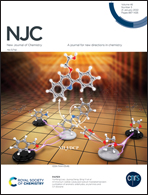Design, synthesis and biological evaluation of novel pteridinone derivatives possessing a sulfonyl moiety as potent dual inhibitors of PLK1 and BRD4†
Abstract
The simultaneous inhibition of PLK1 and BRD4 by a single molecule could lead to the development of an effective therapeutic strategy for a variety of diseases in which PLK1 and BRD4 are implicated. Herein, two series of novel pteridinone derivatives possessing a sulfonyl moiety were designed, synthesized and evaluated for their biological activity. Most compounds exhibited moderate to excellent cytotoxic activity against HCT116, PC3 and BT474 cell lines. Among them, the most promising compound B2 showed high antiproliferative effects on the three cell lines with IC50 values of 0.30 μM, 1.82 μM and 1.69 μM, respectively. In the enzymatic assay, B2 was identified as a potent PLK1 and BRD4 dual inhibitor (PLK1 IC50 = 6.3 nM, BRD4 IC50 = 179 nM). Further explorations in bioactivity were conducted to clarify the anticancer mechanism of compound B2. The results showed that compound B2 obviously inhibited the proliferation of HCT116 cell lines, induced a great decrease in the mitochondrial membrane potential leading to apoptosis of HCT116 cells and arrested the G2 phase of HCT116 cells.



 Please wait while we load your content...
Please wait while we load your content...